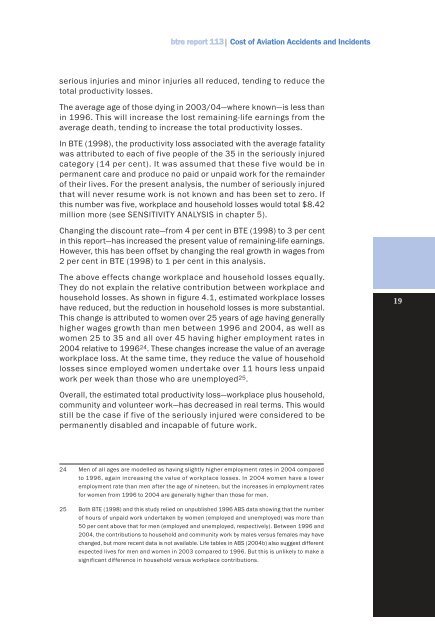PDF: 1050 KB - Bureau of Infrastructure, Transport and Regional ...
PDF: 1050 KB - Bureau of Infrastructure, Transport and Regional ...
PDF: 1050 KB - Bureau of Infrastructure, Transport and Regional ...
- No tags were found...
Create successful ePaper yourself
Turn your PDF publications into a flip-book with our unique Google optimized e-Paper software.
tre report 113| Cost <strong>of</strong> Aviation Accidents <strong>and</strong> Incidentsserious injuries <strong>and</strong> minor injuries all reduced, tending to reduce thetotal productivity losses.The average age <strong>of</strong> those dying in 2003/04—where known—is less thanin 1996. This will increase the lost remaining-life earnings from theaverage death, tending to increase the total productivity losses.In BTE (1998), the productivity loss associated with the average fatalitywas attributed to each <strong>of</strong> five people <strong>of</strong> the 35 in the seriously injuredcategory (14 per cent). It was assumed that these five would be inpermanent care <strong>and</strong> produce no paid or unpaid work for the remainder<strong>of</strong> their lives. For the present analysis, the number <strong>of</strong> seriously injuredthat will never resume work is not known <strong>and</strong> has been set to zero. Ifthis number was five, workplace <strong>and</strong> household losses would total $8.42million more (see SENSITIVITY ANALYSIS in chapter 5).Changing the discount rate—from 4 per cent in BTE (1998) to 3 per centin this report—has increased the present value <strong>of</strong> remaining-life earnings.However, this has been <strong>of</strong>fset by changing the real growth in wages from2 per cent in BTE (1998) to 1 per cent in this analysis.The above effects change workplace <strong>and</strong> household losses equally.They do not explain the relative contribution between workplace <strong>and</strong>household losses. As shown in figure 4.1, estimated workplace losseshave reduced, but the reduction in household losses is more substantial.This change is attributed to women over 25 years <strong>of</strong> age having generallyhigher wages growth than men between 1996 <strong>and</strong> 2004, as well aswomen 25 to 35 <strong>and</strong> all over 45 having higher employment rates in2004 relative to 1996 24 . These changes increase the value <strong>of</strong> an averageworkplace loss. At the same time, they reduce the value <strong>of</strong> householdlosses since employed women undertake over 11 hours less unpaidwork per week than those who are unemployed 25 .19Overall, the estimated total productivity loss—workplace plus household,community <strong>and</strong> volunteer work—has decreased in real terms. This wouldstill be the case if five <strong>of</strong> the seriously injured were considered to bepermanently disabled <strong>and</strong> incapable <strong>of</strong> future work.24 Men <strong>of</strong> all ages are modelled as having slightly higher employment rates in 2004 comparedto 1996, again increasing the value <strong>of</strong> workplace losses. In 2004 women have a loweremployment rate than men after the age <strong>of</strong> nineteen, but the increases in employment ratesfor women from 1996 to 2004 are generally higher than those for men.25 Both BTE (1998) <strong>and</strong> this study relied on unpublished 1996 ABS data showing that the number<strong>of</strong> hours <strong>of</strong> unpaid work undertaken by women (employed <strong>and</strong> unemployed) was more than50 per cent above that for men (employed <strong>and</strong> unemployed, respectively). Between 1996 <strong>and</strong>2004, the contributions to household <strong>and</strong> community work by males versus females may havechanged, but more recent data is not available. Life tables in ABS (2004b) also suggest differentexpected lives for men <strong>and</strong> women in 2003 compared to 1996. But this is unlikely to make asignificant difference in household versus workplace contributions.
















